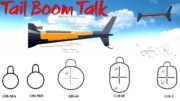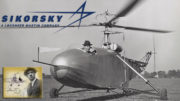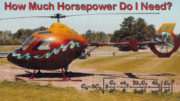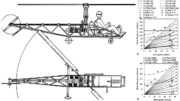Redback Aviation Helicopter Anatomy
We will continue bringing you an overview of how a helicopter works including the basic helicopter layout as it relates to home built, ultralight and experimental helicopters.
VIDEO: How does a helicopter fly?
Parts of a Helicopter
Helicopters are mysterious machines to many, but they have become daily participants in the aviation business segment. To understand how they fly, one has to understand the various major assemblies that make a helicopter what it is and how the parts create and control lift.
The Helicopter’s Main Rotor
The main rotor system produces the helicopter’s primary lifting capability. There are two major sub-assemblies that make up the entire system. The first is the rotor assembly, also known as the rotor hub, and the second is the blades. There are two kinds of rotor assemblies; semi-rigid and rigid.
In the former, the blades are attached to hinge mechanisms (based on the number of individual blades) that allow them to rise up (flap) under pitch and power, and additionally allow them to move forward and aft (lead and lag) to mitigate dissimilarity of lift. In the rigid system, the blades are integrated with the rotor assembly and there are no hinges.
Helicopter Drive Shaft
The helicopter’s drive shaft delivers critical engine power to the main rotor assembly. The assembly also turns a secondary gear set that drives a horizontal shaft, thereby turning the tail rotor.
In effect, should the main drive shaft fail, the aircraft will stop producing motive force, causing an immediate emergency landing. Typical helicopter main drive-shafts are produced from the highest strength materials.
Helicopter Cockpit
The cockpit houses the pilot and crew amenities in addition to the instrument panel and controls. Aside from the obvious in terms of seating, lighting and climate control systems, the central controls for a helicopter include: cyclic (controls left-right-forward-backward movement of the main rotor disc), the collective (controls the pitch of the main rotor) and the tail rotor pedals (controls the yaw of the airframe.)
Helicopter Landing Skids
The helicopters skids are the essential landing mechanism for the typical helicopter. This assembly is typically made of high-strength tubular steel with horizontal and vertical braces.
Aside from the skids themselves, “shoes” are also attached at the vertical braces to allow the helicopter to slide effectively on rough surfaces. Should a shoe be damaged in a landing, the sub-assembly can be removed and replaced without having to replace the entire skid assembly.
Helicopter Engine Bay And Associated Machine Assemblies
The helicopter’s engine bay houses the engine, oil cooler, transmission, electrical generator and radiators, or in the case of an air cooled engine, the fan scroll. Additionally, there are a number of other small machine devices mounted therein, along with other secondary engine-related accessories.
Helicopter Tail Boom
The tail boom houses a “hanging” tail rotor shaft driven by a secondary gear set turned by the main drive-shaft. In addition to housing the shaft, the boom also offers a mounting assembly for the tail-rotor blade system. The boom is typically attached to the cockpit by a series of bolts and can easily be removed for maintenance or other structural necessities.
Helicopter Tail Rotor
The tail-rotor manages and creates horizontal lift (yaw control) via the tail-rotor pedals. These are typically two-blade systems, but 2009’s complex helicopters also offer multi-blade tail-rotor systems, in addition to ducted-fan and high pressure bleed-air reaction control systems (RCS). The latter are sometimes referred to as NOTAR (NoTail) systems.

How a helicopter works: The different parts of a helicopter and how they work.
Though the following animation is of a commercial helicopter swash plate and fully articulated rotor head, it gives clear indication of how the collective and cyclic controls work in a helicopter.
More on How A Helicopter Works
VIDEO: S-61 Sea King Rotor Head Animation
Another similar animation explaining the complexities of helicopter rotorblades control in simple terms.
VIDEO: How It Works Helicopter Blades








Be the first to comment on "Anatomy Of A Helicopter – How A Helicopter Works"